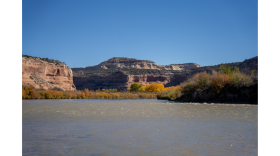-
-
Ronan Donovan spoke on Tuesday as part of the Wheeler Opera House's Changemaker series. He says humans are part of the natural world, and restoring our relationships to animals like wolves will make us happier and healthier.
-
Keystone Resort in Colorado was the first resort in the country to open in 2025, in part due to their emphasis on early-season snowmaking. As climate change amplifies drought in the Mountain West, ski areas across the region are considering how best to use increasingly scarce water resources.
-
New research shows that mountain regions around the world are warming faster than the lowlands below them. Scientists say that could have big consequences for the Mountain West, where communities rely on snow and ice for their water supply.
-
Colorado has been fighting Aquatic Nuisance Species or ANS for years. Aquatic invasives are often small unremarkable invertebrates; it isn't obvious how much damage they can cause to native environments, human infrastructure, and biodiversity across the West.
-
A 2023 Supreme Court ruling, along with new interpretations from the Trump administration, have limited protections for rivers and wetlands. Colorado is looking to fill in that gap with its own regulatory program.
-
New research shows that many rural roads in the Mountain West may be more vulnerable to flooding than people realize. That’s because the culverts and stream crossings underneath them aren’t built to handle today’s storms.
-
Warmer temperatures in November meant that less snowpack accumulated. But storms did increase soil moisture in the Upper Colorado River Basin, making future precipitation more likely to run off slopesides and boost rivers and streams.
-
The narrowed pool of waters receiving federal protection under the rule could be severe for critical wetlands and streams in the arid West, many of which are seasonal or fed by groundwater.
-
At a conference of western governors in Arizona last week, the region's energy future dominated the conversion as populations and the AI data center industry continue to grow and drive up demand.
-
A new study in the Rocky Mountains has found a steep drop in the number of young American pikas — small, high-altitude mammals known for their distinctive squeaks and rock-pile homes. Researchers say the 50% decline could be an early sign of deeper ecological shifts as the climate warms.
-
A new study in the journal Science suggests rivers in the arid American West may be doing something unexpected: absorbing carbon dioxide from the atmosphere. The finding could reshape how scientists model climate change.
















